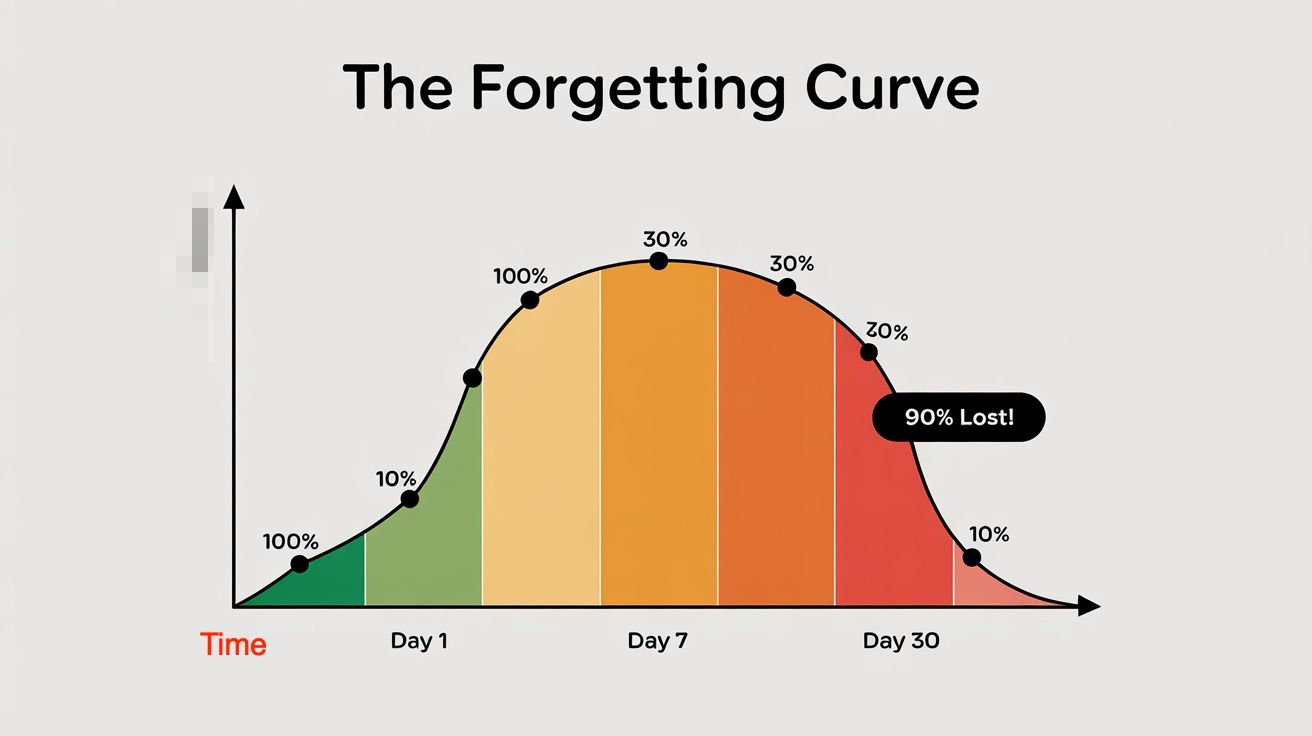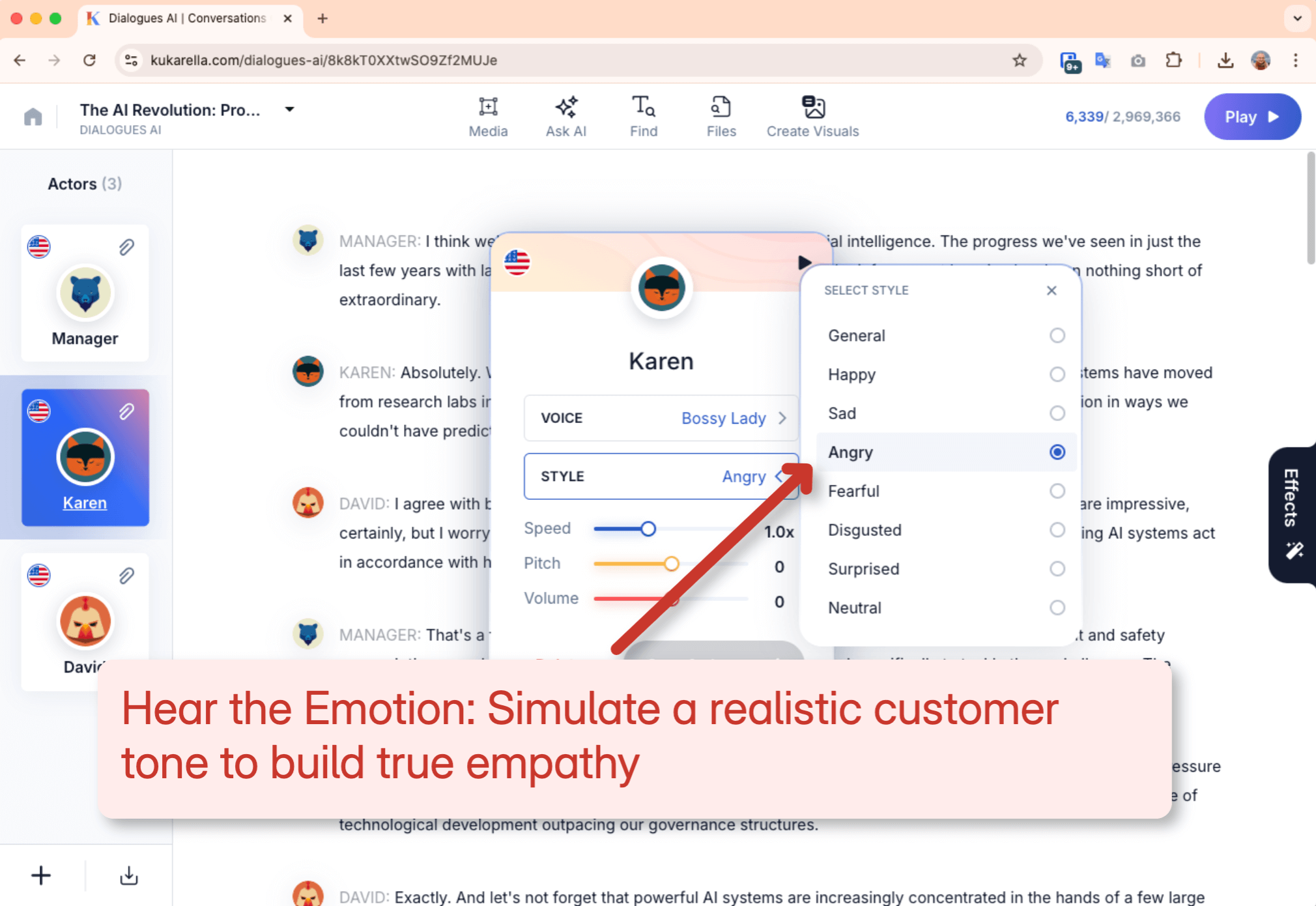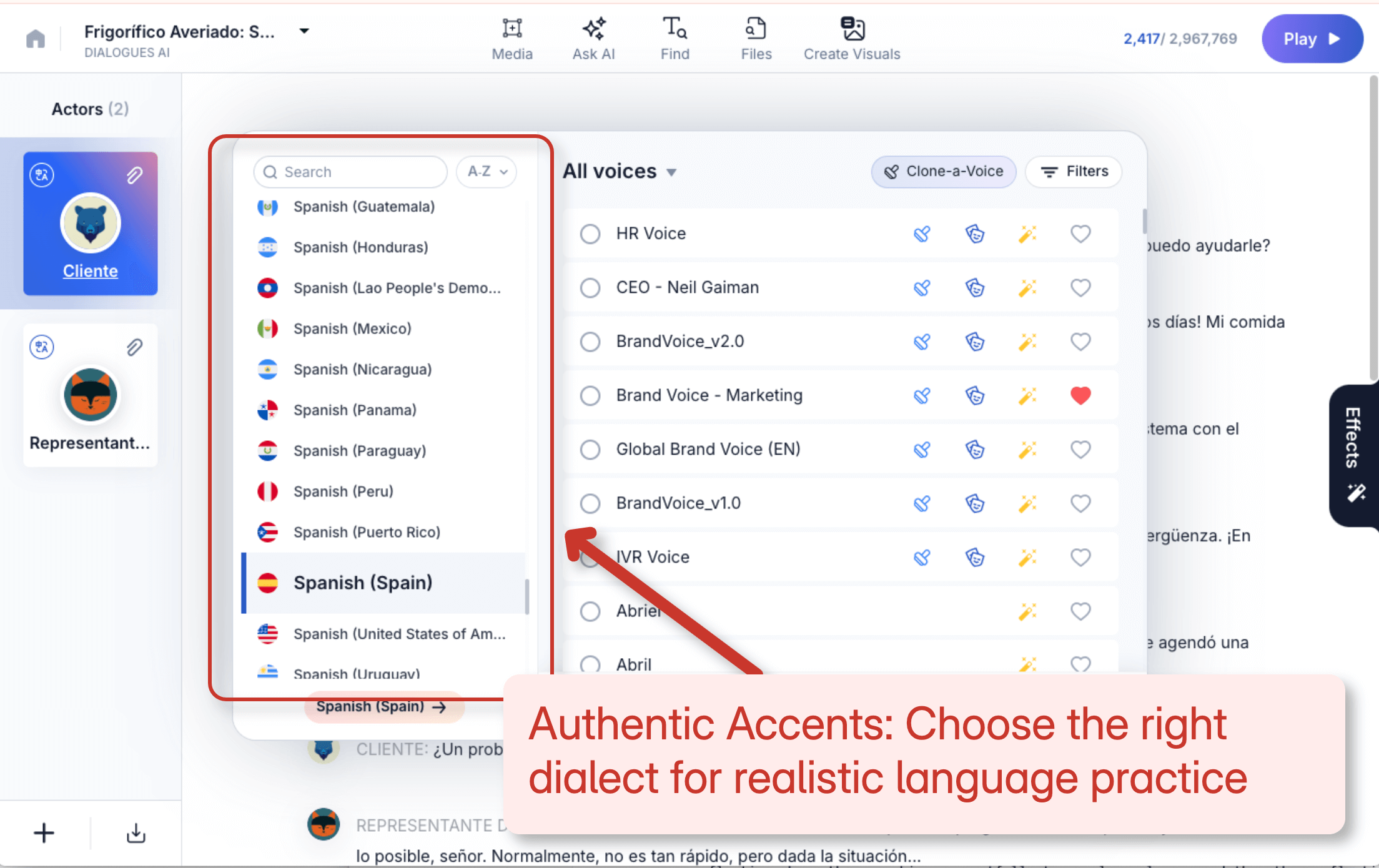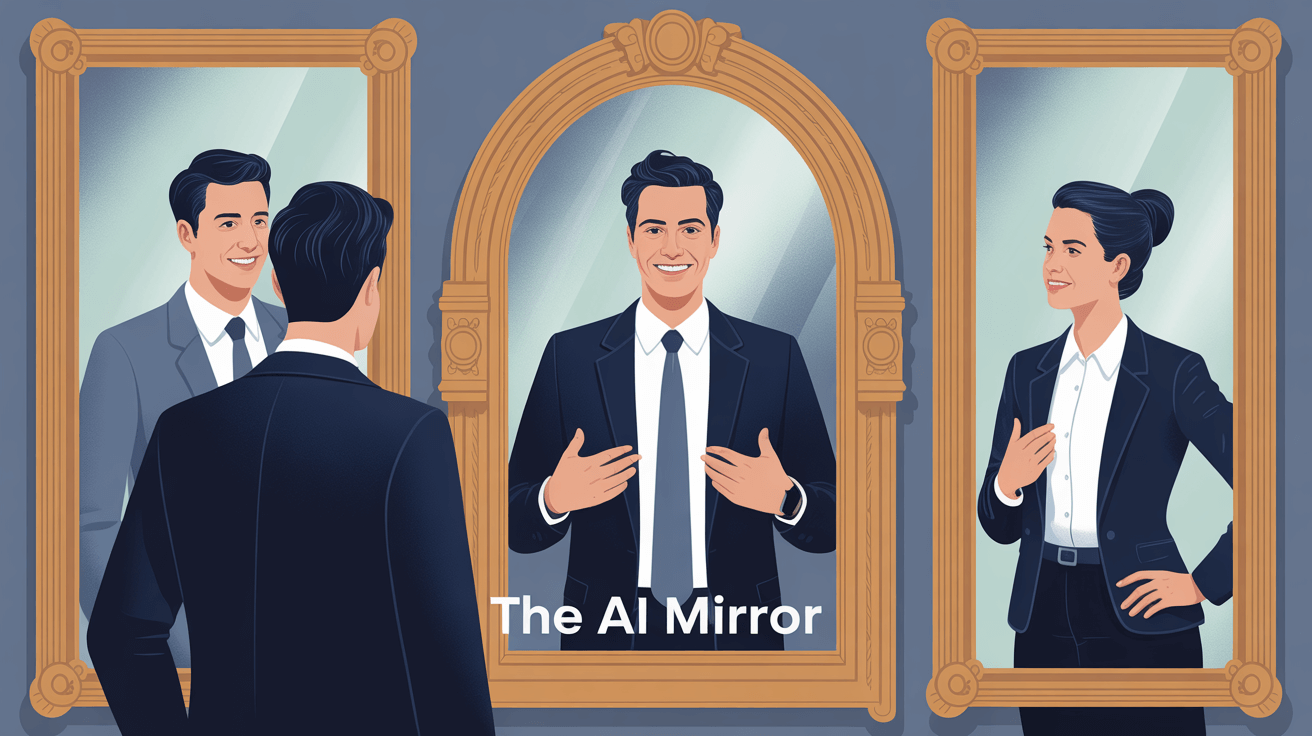 A corporate training session
A corporate training session It's a scene that plays out in thousands of conference rooms every year. Two sales reps, Mark and Sarah, are asked to role-play a difficult client negotiation in front of their peers. Mark, feeling awkward, gives a half-hearted, unconvincing performance. Sarah, not wanting to make her colleague look bad, immediately concedes. The trainer offers some generic feedback. The entire exercise is a cringeworthy waste of time, and worse, a moment of "learning" is lost forever.
This is the failure of traditional role-play. It’s a powerful pedagogical theory crippled by poor execution, human awkwardness, and a lack of realism. The alternative, until now, has been bland, text-based scenarios or "death by PowerPoint," which are even less effective. A 2019 study on corporate training found that employees forget, on average, 50% of the information presented in a training session within one hour, and 90% within a month if not reinforced.
 An infographic of the Ebbinghaus "Forgetting Curve"
An infographic of the Ebbinghaus "Forgetting Curve" The core problem is a lack of engagement and emotional resonance. We don't learn from information; we learn from experience.
Now, a new generation of AI tools is solving this problem by creating perfectly crafted, emotionally resonant, and infinitely scalable training scenarios. An AI Dialogue Generator is not just a scriptwriter; it's a simulation engine for human interaction. It allows trainers and educators to move beyond theory and give their learners a safe, repeatable space to practice real-world conversations.
This report is a deep dive into the strategy and execution of AI-powered dialogue for training and education. We will explore how these specialized tools are custom-tuned to create realistic conflict, how they integrate with voice technology to create full audio simulations, and why this method is proving to be a quantum leap in learning effectiveness.
Why Most AI Fails at Dialogue: The "Politeness" Problem
If you've used a general-purpose AI like ChatGPT to create a dialogue, you've likely noticed a problem: it's too polite. The characters agree too easily, the conflict is superficial, and the conversation feels sterile. This is because these models are optimized for helpful, non-confrontational answers. They are terrible at simulating the messy, irrational, and emotional reality of human conversation.
A specialized AI Dialogue Generator, like the one built into Kukarella, is different by design. It operates with a custom-tuned system message, an underlying instruction that acts as its creative director.
Kukarella's "Secret Sauce": The Drama by Default Engine
 Seasoning a script with "drama"
Seasoning a script with "drama" The AI Assistant has a built-in directive: "When asked to create a dialogue, do not just provide a simple Q&A. Your primary goal is to create a believable and engaging narrative. Introduce realistic stakes, subtle emotional cues, and points of disagreement or misunderstanding. The characters should have distinct personalities and goals. Make it a story, not just an exchange."
This is the critical difference. It's an AI that understands its job is not just to answer, but to engage.
The Tool Ecosystem for Dialogue Generation
| Tool | Primary Focus | Key Dialogue Feature | Best For |
| Kukarella | Integrated Content Suite | Drama-by-Default AI & Integrated Casting. Generates engaging, conflict-driven scripts and allows immediate voice assignment and emotional direction in one place. | Trainers and educators who need a seamless, end-to-end "scenario-to-simulation" workflow. |
| ChatGPT / Claude | Generalist AI Chatbots | Creative Flexibility. Can generate highly creative and nuanced dialogues, but requires extensive prompt engineering to add realistic conflict. | Instructional designers who are skilled prompters and will manually move the script to a separate audio tool. |
| Descript | Audio/Video Editor | Multi-Speaker Transcription. Excellent for transcribing existing human conversations, but does not have a dedicated AI dialogue generation feature. | Teams that are recording their own role-play sessions and need to transcribe and edit them. |
| Vyond / Articulate | E-Learning Authoring Tools | Visual Scenarios. Focuses on creating animated video scenarios, often with text-based dialogue or basic stock TTS voices. | L&D departments creating full, video-based e-learning courses who need simple dialogue as one component. |
The Scenario-Based Learning Playbook: 4 High-Impact Use Cases
Here are four documented strategies that trainers and educators are using to create powerful learning experiences.
Strategy 1: "The Empathy Engine" (Customer Service Training)
The goal is to train support agents to de-escalate angry customers with empathy and precision.
- The Old Way: A multiple-choice quiz on company policy.
- The AI Workflow:
- The Prompt:"Create a realistic dialogue between an angry customer, 'Karen,' whose expensive wedding gift delivery was missed, and a support agent, 'David.' Karen is emotional and feels ignored. David's goal is to use the A.C.E. method (Acknowledge, Clarify, Empathize) to de-escalate the situation and find a solution."
- The AI Result: The AI generates a script where "Karen" is not just "angry" but provides specific, emotional reasons for her anger ("You've ruined my best friend's wedding!"). It forces "David" to respond to emotional cues, not just factual problems.
- The Audio Simulation: The trainer then uses Kukarella's DialoguesAI to cast the roles. They assign a "Sad" or "Angry" emotional style to Karen's voice and a "Calm" or "Narrative" style to David's.
 Emotional styles in a training dialogue
Emotional styles in a training dialogue- The Learning Outcome: The trainee doesn't just read about empathy; they hear it in action. They hear the shift in Karen's tone as the agent successfully de-escalates the call. This creates a powerful and memorable emotional template for their own future interactions.
Audio created by Kukarella
Strategy 2: "The Historical Re-enactment" (Education)
The goal is to bring a dry historical event to life for a high school history class.
- The User Problem (via an Edutopia article):"Students see historical figures as marble statues. They don't connect with them as people who faced real dilemmas."
- The AI Workflow:
- The Prompt:"Create a historically plausible dialogue between President Abraham Lincoln and his top general, George McClellan, in late 1862. Lincoln is frustrated with McClellan's inaction and cautiousness. McClellan is proud and defensive, believing he is preserving the army. The dialogue should reveal their conflicting personalities and strategic disagreements."
- The Audio Simulation: The teacher assigns two distinct, age-appropriate male voices. They might slow the Speed of Lincoln's voice to make him sound more deliberate and thoughtful, and keep McClellan's at a normal pace to reflect his defensiveness.
- The Learning Outcome: Students hear the tension and frustration. History is transformed from a list of dates and battles into a human drama, leading to deeper comprehension and retention.
Strategy 3: "The Compliance Crucible" (HR & Legal Training)
The goal is to train managers on how to navigate a legally sensitive conversation, like addressing an employee's frequent tardiness.
- The AI Workflow:
- The Prompt:"Create a training dialogue for a new manager on how to discuss repeated tardiness with an employee who is a high performer but is struggling with personal issues. The manager must be supportive but also clearly state the company policy and the consequences. The employee should be defensive at first, then reveal a personal challenge."
- The Learning Outcome: This creates a safe space to practice a high-stakes conversation. The generated script can be analyzed for legal compliance and best practices. It's a repeatable simulation that is far more effective than a dry policy document.
Strategy 4: "The Language Lab" (Second Language Acquisition)
The goal is to provide language learners with realistic, conversational practice.
- The AI Workflow:
- The Prompt:"Create a short, casual dialogue in Spanish between two friends meeting at a café in Madrid. Include common slang and colloquialisms. One friend is ordering a 'café con leche' and a 'tortilla española'."
- The Audio Simulation: The teacher uses two native Spanish (Castilian) voices from Kukarella's library.
 Kukarella's voice library
Kukarella's voice library- The Learning Outcome: The student hears the language as it is actually spoken, complete with natural pacing and cultural context, a far cry from the stilted "textbook" conversations.
"Plot Twist" Moment: The AI Is a Mirror for Your Own Biases
 AI Mirror
AI MirrorThe conventional use of this technology is to create perfect, idealized conversations. But its most powerful, advanced application is to do the opposite: to create flawed conversations in order to reveal a learner's hidden biases.
The Twist: As a trainer, you can intentionally prompt the AI to create a "bad" example.
- The Prompt:"Create a dialogue where a sales manager gives 'Jim,' a senior male employee, constructive feedback on a failed project, and then gives 'Jane,' a junior female employee, the exact same feedback. The manager's tone towards Jane should be subtly condescending and use diminutive language, while his tone towards Jim is collaborative and respectful."
When you play this audio simulation in a training session, it becomes a powerful, undeniable tool for uncovering unconscious bias. Learners can hear the subtle differences in tone and language that they might miss in a text. The AI becomes a mirror, reflecting the hidden patterns in our communication and opening the door for genuine self-correction and growth.
Implementation Guide: Your First Dialogue in 5 Minutes
- Step 1: Define Your Objective. What is the single most important thing you want your learner to take away from this conversation? (e.g., "Learn to say no to scope creep.")
- Step 2: Write Your "Persona Prompt." Open Kukarella's AI Assistant. Start with the characters and their motivations. "Create a dialogue between a project manager who is trying to protect their team from burnout, and a client who keeps adding 'small' requests to the project."
- Step 3: Generate and Refine. Generate the script. Read it. Does it feel real? If not, use the "Ask AI" tool to refine it: "Add few lines to client to make him sound more demanding and urgent."
- Step 4: Cast and Direct. Check assigned voices. Use default ones or choose new voices. Use the Emotional Styles and effects sliders. Maybe the project manager's voice is "Calm" but with a slightly slower Speed, while the client's is "Neutral" but at 1.1x Speed.
- Step 5: Listen and Learn. Play the scene. Hearing it aloud is the final test. The combination of the dramatic script and the directed vocal performance creates the finished learning asset.
Frequently Asked Questions (FAQ)
Q: Can the AI create dialogues with more than two speakers?
A: Yes. You can specify the number of characters in your prompt (e.g., "Create a three-person dialogue..."). The AI will then create distinct parts, and in a tool like Kukarella, you can create and assign a unique voice to each speaker.
Q: What if the dialogue the AI creates doesn't meet our specific learning objectives?
A: You are always the final editor. If the AI's creative choices stray too far, you can edit the text directly to ensure key policy points or learning objectives are included. The AI provides the engaging frame; you ensure the pedagogical core is sound.
Q: How can we measure the effectiveness of this type of training?
A: Use pre- and post-simulation assessments. Before the training, give learners a multiple-choice quiz on a scenario. After they've engaged with the audio dialogue, give them a similar quiz. A significant improvement in their scores is a strong indicator of the training's effectiveness. Qualitative feedback on how "realistic" and "helpful" the scenarios were is also a key metric.
You can't learn to swim by reading a book about it. For the critical skills of communication, negotiation, and empathy, there is no substitute for practice. AI Dialogue Generators finally make it possible to scale that practice, creating a new generation of learning tools that are not just informative, but truly transformative.